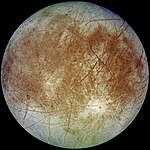
Space exploration is the use of astronomy and space technology to explore outer space. While the exploration of space is currently carried out mainly by astronomers with telescopes, its physical exploration is conducted both by uncrewed robotic space probes and human spaceflight. Space exploration, like its classical form astronomy, is one of the main sources for space science.

Space colonization is the use of outer space or celestial bodies other than Earth for permanent habitation or as extraterrestrial territory.

Callisto, or Jupiter IV, is the second-largest moon of Jupiter, after Ganymede. In the Solar System it is the third-largest moon after Ganymede and Saturn's largest moon Titan, and as large as the smallest planet Mercury, though only about a third as massive. Callisto is, with a diameter of 4821 km, roughly a third larger than the Moon and orbits Jupiter on average at a distance of 1883000 km, which is about six times further out than the Moon orbiting Earth. It is the outermost of the four large Galilean moons of Jupiter, which were discovered in 1610 with one of the first telescopes, being visible from Earth with common binoculars.

Europa, or Jupiter II, is the smallest of the four Galilean moons orbiting Jupiter, and the sixth-closest to the planet of all the 95 known moons of Jupiter. It is also the sixth-largest moon in the Solar System. Europa was discovered independently by Simon Marius and Galileo Galilei and was named after Europa, the Phoenician mother of King Minos of Crete and lover of Zeus.
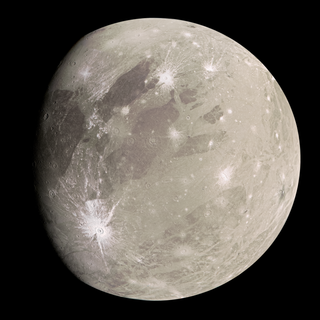
Ganymede, or Jupiter III, is the largest and most massive natural satellite of Jupiter as well as in the Solar System, being a planetary-mass moon. It is the largest Solar System object without an atmosphere, despite being the only moon in the Solar System with a magnetic field. Like Titan, it is larger than the planet Mercury, but has somewhat less surface gravity than Mercury, Io or the Moon.

The Jupiter Icy Moons Orbiter (JIMO) was a proposed NASA spacecraft designed to explore the icy moons of Jupiter. The main target was Europa, where an ocean of liquid water may harbor alien life. Ganymede and Callisto, which are now thought to also have liquid, salty oceans beneath their icy surfaces, were also targets of interest for the probe.
Many parts of the outer Solar System have been considered for possible future colonization. Most of the larger moons of the outer planets contain water ice, liquid water, and organic compounds that might be useful for sustaining human life.
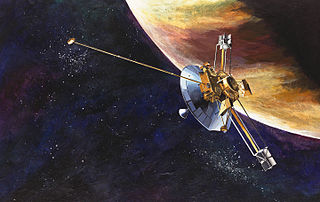
The exploration of Jupiter has been conducted via close observations by automated spacecraft. It began with the arrival of Pioneer 10 into the Jovian system in 1973, and, as of 2023, has continued with eight further spacecraft missions in the vicinity of Jupiter. All of these missions were undertaken by the National Aeronautics and Space Administration (NASA), and all but two were flybys taking detailed observations without landing or entering orbit. These probes make Jupiter the most visited of the Solar System's outer planets as all missions to the outer Solar System have used Jupiter flybys. On 5 July 2016, spacecraft Juno arrived and entered the planet's orbit—the second craft ever to do so. Sending a craft to Jupiter is difficult, mostly due to large fuel requirements and the effects of the planet's harsh radiation environment.

The exploration of Uranus has, to date, been through telescopes and a lone probe by NASA's Voyager 2 spacecraft, which made its closest approach to Uranus on January 24, 1986. Voyager 2 discovered 10 moons, studied the planet's cold atmosphere, and examined its ring system, discovering two new rings. It also imaged Uranus' five large moons, revealing that their surfaces are covered with impact craters and canyons.
Io Volcano Observer (IVO) is a proposed low-cost, outer-planet mission to explore Jupiter's moon Io to understand tidal heating as a fundamental planetary process. The main science goals are to understand (A) how and where tidal heat is generated inside Io, (B) how tidal heat is transported to the surface, and (C) how Io is evolving. These results are expected to have direct implications for the thermal history of Europa and Ganymede as well as provide insights into other tidally heated worlds such as Titan and Enceladus. The IVO data may also improve our understanding of magma oceans and thus the early evolution of the Earth and Moon.
Laplace-P was a proposed orbiter and lander by the Russian Federal Space Agency designed to study the Jovian moon system and explore Ganymede with a lander.

The Jupiter Icy Moons Explorer is an interplanetary spacecraft that was launched on 14 April 2023 from Guiana Space Centre in the French Guiana by the European Space Agency (ESA) with Airbus Defence and Space as the main contractor. The mission is planned to study Ganymede, Callisto, and Europa, three of Jupiter's Galilean moons. They are thought to have significant bodies of liquid water beneath their icy surfaces which would make them potentially habitable environments.
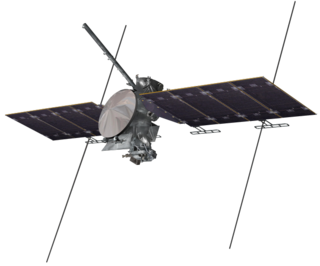
Europa Clipper is an interplanetary mission in development by NASA comprising an orbiter. Planned for launch in October 2024, the spacecraft is being developed to study the Galilean moon Europa through a series of flybys while in orbit around Jupiter.
Planetary oceanography also called astro-oceanography or exo-oceanography is the study of oceans on planets and moons other than Earth. Unlike other planetary sciences like astrobiology, astrochemistry and planetary geology, it only began after the discovery of underground oceans in Saturn's moon Titan and Jupiter's moon Europa. This field remains speculative until further missions reach the oceans beneath the rock or ice layer of the moons. There are many theories about oceans or even ocean worlds of celestial bodies in the Solar System, from oceans made of diamond in Neptune to a gigantic ocean of liquid hydrogen that may exist underneath Jupiter's surface.
Journey to Enceladus and Titan (JET) is an astrobiology mission concept to assess the habitability potential of Enceladus and Titan, moons of Saturn.

The Europa Lander is a proposed astrobiology mission concept by NASA to send a lander to Europa, an icy moon of Jupiter. If funded and developed as a large strategic science mission, it would be launched in 2027 to complement the studies by the Europa Clipper orbiter mission and perform analyses on site.
The future of space exploration involves both telescopic exploration and the physical exploration of space by robotic spacecraft and human spaceflight.
Trident is a space mission concept to the outer planets proposed in 2019 to NASA's Discovery Program. The concept includes flybys of Jupiter and Neptune with a focus on Neptune's largest moon Triton.
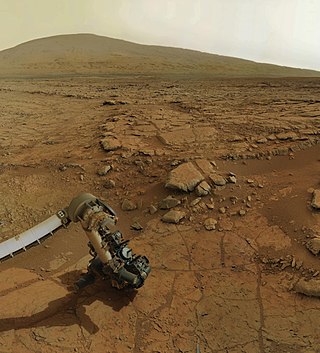
Planetary habitability in the Solar System is the study that searches the possible existence of past or present extraterrestrial life in those celestial bodies. As exoplanets are too far away and can only be studied by indirect means, the celestial bodies in the Solar System allow for a much more detailed study: direct telescope observation, space probes, rovers and even human spaceflight.













